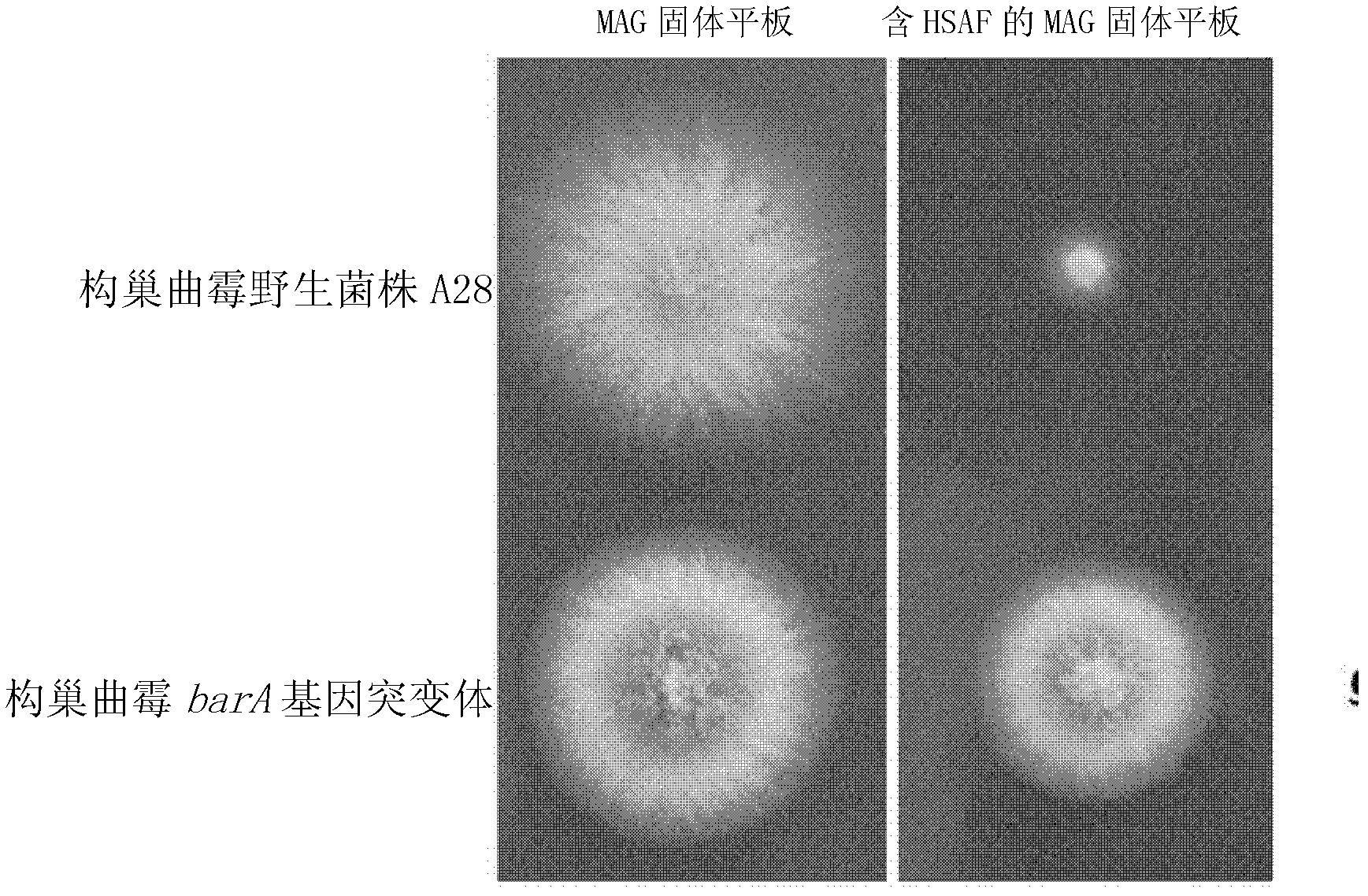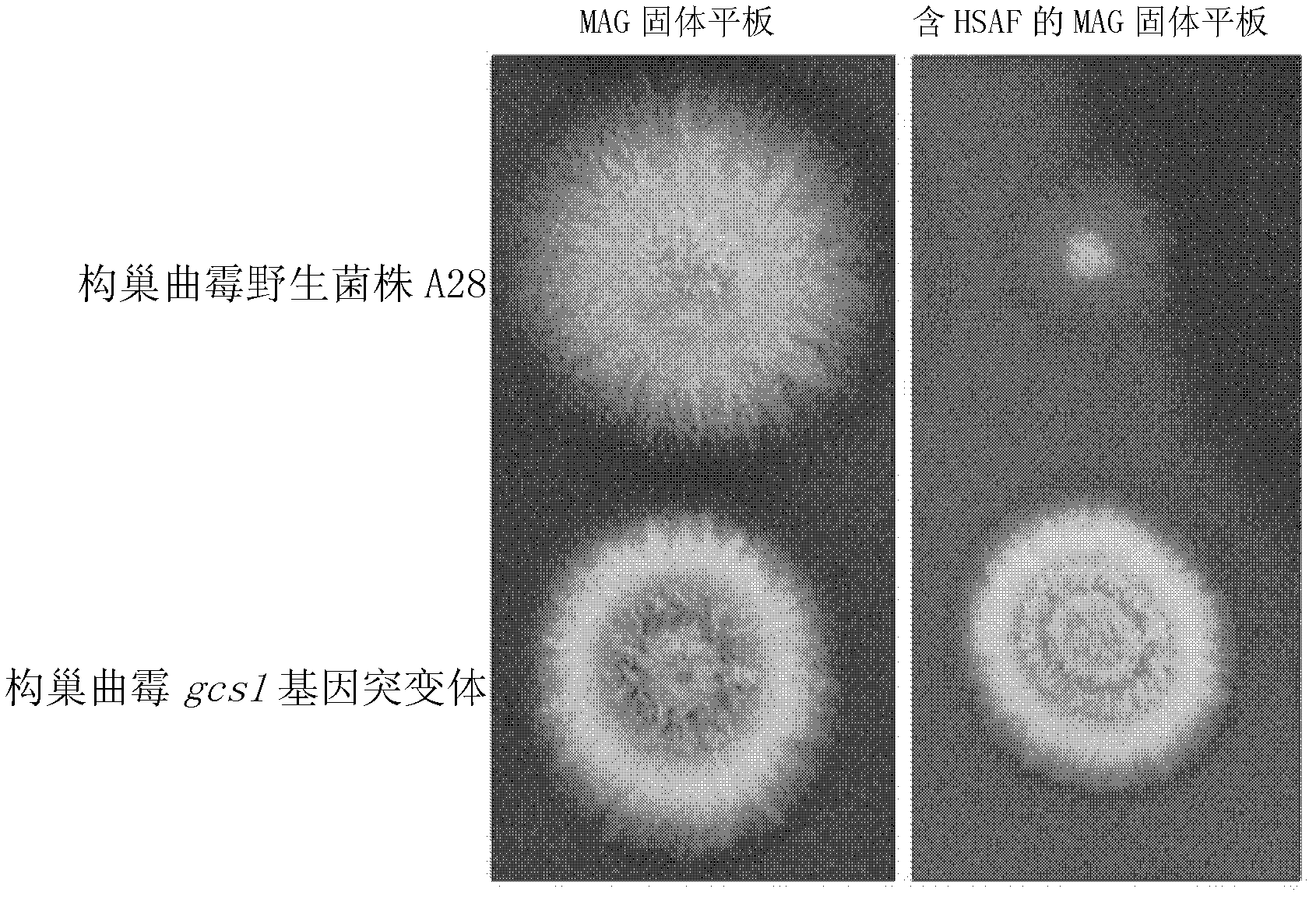Method for screening antifungal substance acting on glucosylceramide as target
A technology of ceramide glycolipid and ceramide, applied in the field of antifungal substances, can solve the problems of unclear target and toxicity of antifungal substances, large workload, etc., and achieve the effects of accurate and reliable results, simple screening process and clear targets
- Summary
- Abstract
- Description
- Claims
- Application Information
AI Technical Summary
Problems solved by technology
Method used
Image
Examples
Embodiment 1
[0035] Embodiment 1, the construction of two mutant bacterial strains
[0036] 1. Ultraviolet mutagenesis of Aspergillus nidulans wild strain A28
[0037] The spores of Aspergillus nidulans wild bacterial strain A28 were spread onto the MAG solid plate containing 50 μg / ml HSAF, under the ultraviolet lamp (100J / m 2 , the lethal rate was 90%) for mutagenesis treatment.
[0038] 2. Screening and identification of barA gene mutants and gcs1 gene mutants of Aspergillus nidulans
[0039] 1. Place the mutagenized plate at 28°C for 3 days, then pick large colonies and place them on a MAG solid plate containing 50 μg / ml HSAF for further confirmation.
[0040] 2. Using the mutant genomic DNA as a template, PCR amplifies the barA gene (ceramide synthetase gene) and performs sequencing analysis. Using the mutant genomic DNA as a template, the gcs1 gene (glycosylceramide transferase gene) was amplified by PCR and sequenced. If there is a mutation in the barA gene, gcs1 gene, or both th...
Embodiment 2
[0053] Embodiment 2, the preparation of antifungal factor (HSAF)
[0054] Antifungal factor (HSAF): an antifungal substance from Lysobacter enzymogenes C3 that targets ceramide glycolipids (Rittenour, W.R., Chen, M., Cahoon, E.B., and Harris, S.D. (2011 ). Control of glucosylceramide production and morphogenesis by the Bar1 ceramide synthase in Fusarium graminearum. PLoS One 6, e19385. doi: 10.1371 / journal.pone.0019385).
[0055] HSAF was prepared according to the method in the literature (Yu F, Zaleta-Rivera K, Zhu X, Huffman J, Millet JC, et al. (2007) Structure and biosynthesis of heat-stable antifungal factor (HSAF), a broad-spectrum antimycotic with a novel mode of action. Antimicr Agents Chemoth 51:64-72.).
Embodiment 3
[0056] Embodiment 3, the inhibitory effect of HSAF on wild strain and mutant strain
[0057] 1. HSAF treatment and morphology observation
[0058] Aspergillus nidulans barA gene mutants were respectively placed in the middle of two solid plates (the first solid plate was a MAG solid plate, and the second solid plate was a MAG solid plate containing 50 μg / ml HSAF), and cultured at 28° C. for 3 days.
[0059] Aspergillus nidulans gcs1 gene mutants were respectively placed between two solid plates (the first solid plate was a MAG solid plate, and the second solid plate was a MAG solid plate containing 50 μg / ml HSAF), and cultured at 28° C. for 3 days.
[0060] Aspergillus nidulans wild strain A28 was placed in the middle of two solid plates (the first solid plate was a MAG solid plate, and the second solid plate was a MAG solid plate containing 50 μg / ml HSAF), and cultured at 28°C for 3 days.
[0061] see results figure 1 with figure 2 . On the first solid plate, there was n...
PUM
 Login to View More
Login to View More Abstract
Description
Claims
Application Information
 Login to View More
Login to View More - R&D
- Intellectual Property
- Life Sciences
- Materials
- Tech Scout
- Unparalleled Data Quality
- Higher Quality Content
- 60% Fewer Hallucinations
Browse by: Latest US Patents, China's latest patents, Technical Efficacy Thesaurus, Application Domain, Technology Topic, Popular Technical Reports.
© 2025 PatSnap. All rights reserved.Legal|Privacy policy|Modern Slavery Act Transparency Statement|Sitemap|About US| Contact US: help@patsnap.com



